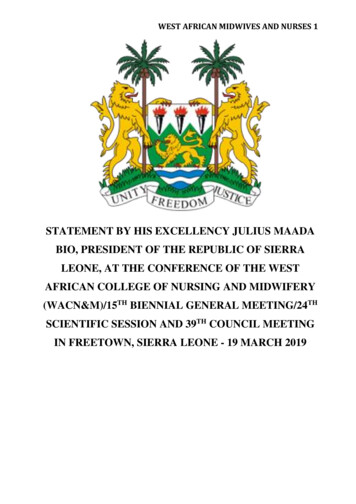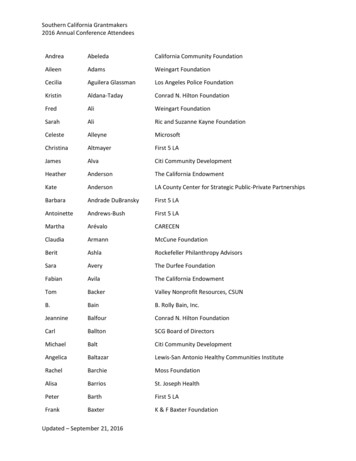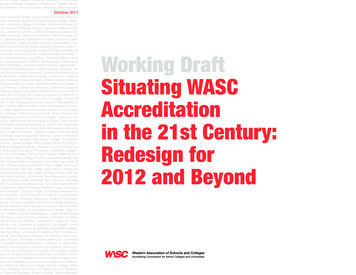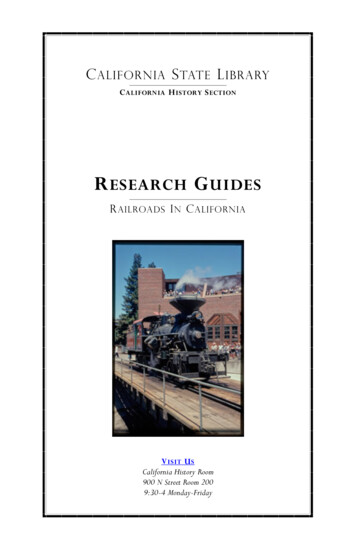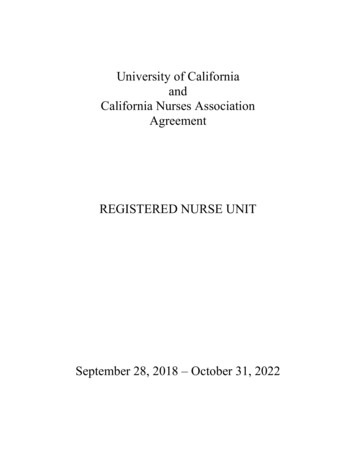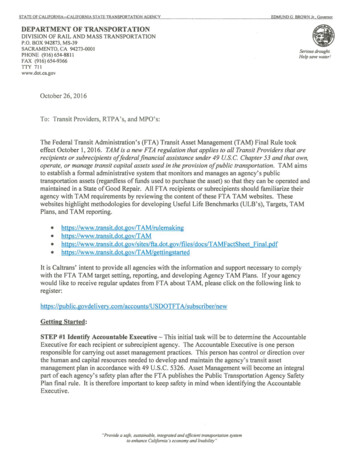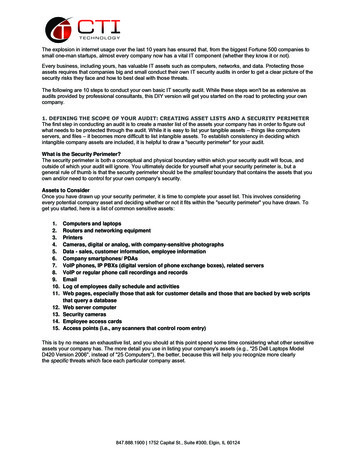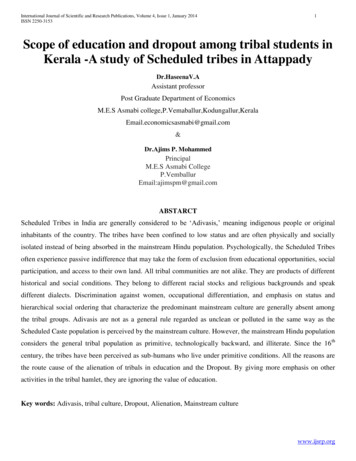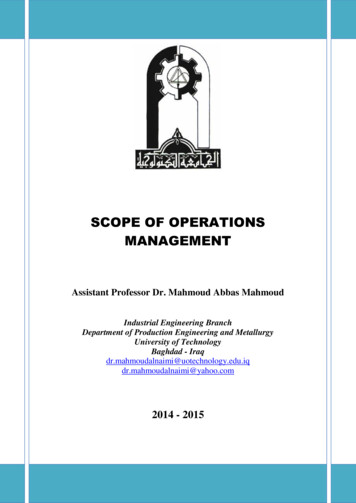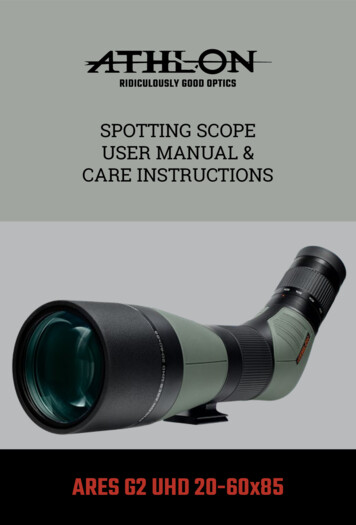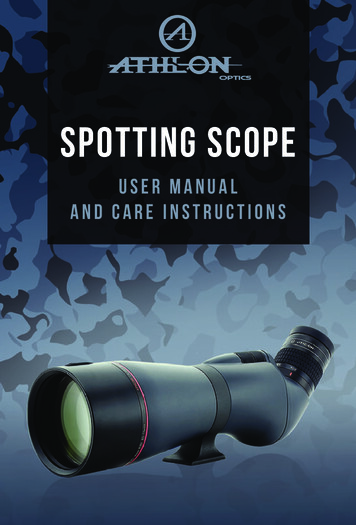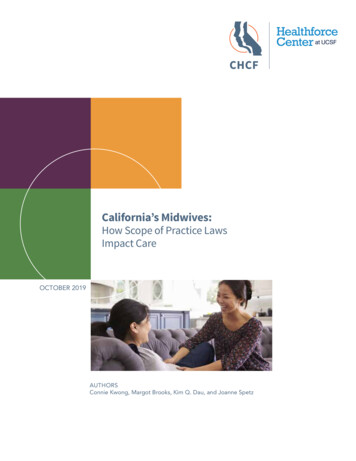
Transcription
California’s Midwives:How Scope of Practice LawsImpact CareOCTOBER 2019AUTHORSConnie Kwong, Margot Brooks, Kim Q. Dau, and Joanne Spetz
ContentsThe AuthorsConnie Kwong is a research analyst at thePhilip R. Lee Institute for Health Policy Studiesat the University of California, San Francisco(UCSF). Margot Brooks was a law studentat UC Hastings at the time this was written.Kim Q. Dau is an associate clinical professorat the UCSF School of Nursing and directorof the Nurse-Midwife/Women’s Health NursePractitioner program at UCSF. Joanne Spetzis a professor at the Philip R. Lee Institute forHealth Policy Studies and associate directorfor research at Healthforce Center at UCSF.AcknowledgmentsThe authors thank the following people forproviding information included in this brief:Kathleen Belzer, CNM; Diane Holzer, LM,CPM, PA-C; Susan Jenkins, JD; and HollySmith, MSN, MPH, CNM.3 Introduction4 Overview of the Profession7 Midwife Education9 Practice Oversight of Midwives in California10 Overview of Regulations in Other States12 Examining the Evidence for Practice Expansion:A Summary of Research19 Appendix: The Landscape of Midwiferyin California21 EndnotesAbout the FoundationThe California Health Care Foundation isdedicated to advancing meaningful, measurable improvements in the way the health caredelivery system provides care to the people ofCalifornia, particularly those with low incomesand those whose needs are not well servedby the status quo. We work to ensure thatpeople have access to the care they need,when they need it, at a price they can afford.CHCF informs policymakers and industryleaders, invests in ideas and innovations,and connects with changemakers to createa more responsive, patient-centered healthcare system.For more information, visit www.chcf.org.California Health Care FoundationABOUT THIS SERIESThis paper is one of a series that examines the scope ofpractice of selected California health professions. Theseries looks at professions discussed by the CaliforniaFuture Health Workforce Commission and its subcommittees and workgroups during spring and summer of2018. Each brief begins by describing the profession,including its legally permissible scope of work, andeducational requirements. The brief then outlines howCalifornia’s permissible scope of practice compareswith that of other states and provides a summary ofresearch studies on the impact of the profession’sscope of practice on access to care, care quality, andcosts. Finally, it summarizes demographic characteristics, practice settings, and geographic distribution.Visit www.futurehealthworkforce.org to learn more.www.chcf.org2
IntroductionCalifornia and the United States face shortages ofqualified clinicians to provide prenatal, labor, andpostpartum care, as well as women’s health services.1–3There has been no growth in the number of obstetricians nationwide since 1980 despite increases inthe number of women of childbearing age and thenumber of births.4 To ensure that women’s health careneeds are met, national organizations recommend thatthe midwifery workforce increase and that midwiveswork within a system of care that fosters collaborationamong licensed, independent providers.5Historically, midwifery has been a profession thatfocuses on care for mothers and infants during prenatal, labor, and postpartum periods. The word“midwife” means “with woman,” and the midwifemodel of care is, fundamentally, woman-centered.Midwifery recognizes pregnancy and childbearing asnormal physiological processes and seeks to delivercare that empowers women to assume responsibilityfor their health and their families’ health. Increasingly,midwifery practice — especially that of nurse-midwives — has expanded its focus to include primarycare and sexual and reproductive health.statues, regulatory bodies, licensing policies, andoften different practice environments. Consequently,the two professions’ respective scopes of practice differ as well. In 2019 there were 386 LMs licensed inCalifornia,6 and in October 2019 there were 753 NMsin California.7 As seen in Table 1, the number of birthsin California attended by LMs and NMs between 2007and 2017 rose, while the number attended by doctorsof medicine declined. In 2017, LMs attended 0.6%of births, with 21% of these occurring in freestandingbirth centers and 74% occurring in residences; in thatyear, NMs attended 10.5% of births in California, withmore than 97% occurring in hospitals (Table 2).Table 2. B irth Settings, by Practitioner, California, 2017DOCTOR OFMEDICINE(MD)In 99.98%)(100.00%)(97.76%)(2.89%)00FreestandingBirth oss the United States, midwives practice subjectto each state’s licensing and regulatory environments.In California, midwives may practice either as nursemidwives (NMs) or licensed midwives (LMs). These areofficially two distinct professions with different education requirements, certifying organizations, enablingDOCTOR OFNURSEOSTEOPATHY 7%)1949(0.04%)(1.69%)00Notes: Other midwife is the terminology the CDC uses for non-nursemidwives. There may be errors in the data associated with hospital birthattendance. California birth certificates also do not state the planned birthlocation.Table 1. N umber of Annual Births, by Practitioner, California, 2007–172007Doctor of Medicine (MD)2008200920102011201220132014501,262 486,714 461,951 443,563 435,221 434,621 421,882 426,326201520162017411,158 405,219 386,646Doctor of Osteopathy 5925,02726,86027,414Nurse-Midwife 3962,6572,8492,8212,908Other (e.g., 4,7554,6794,759Unknown or not stated285270288331313349312332302332394Licensed Midwife (LM)Source (Tables 1 and 2): United States Department of Health and Human Services, Centers for Disease Control and Prevention (CDC), National Center forHealth Statistics, Division of Vital Statistics, Natality Public-Use Data 2007–2017, on CDC WONDER Online Database, October 2018.California’s Midwives: How Scope of Practice Laws Impact Carewww.chcf.org3
Midwives are common providers for prenatal careand birth in many countries, including most Europeancountries, Canada, and Australia.8 It has beenreported that 50% to 75% of births are attended bymidwives in other developed countries.9,10 Midwiferyhas been described as a healing or holistic model ofcare in comparison with the medical model of carethat physicians practice. Direct comparisons betweenmidwives and physicians can be challenging becausethe philosophies of these models of care are different. Nevertheless, a large body of research (discussedlater in this paper) finds that midwife care results incomparable or improved health outcomes for lowand moderate-risk mothers and infants compared withphysician care. Additionally, the literature suggests thatmidwives help improve access to care for underservedcommunities and can help achieve health care expenditure savings. The research also finds that restrictionson midwives’ scope of practice may limit their supplyand, consequently, the utilization of midwives.This paper provides information on the different professional licensures, regulatory schemes, and scopes ofpractice for midwives in California and briefly reviewshow midwifery regulations differ across other states.Additionally, the paper summarizes recent research onhow these laws impact health care access, quality, productivity, and costs.Overview of theProfessionThere are two categories of licensees authorized toprovide midwifery services in California: licensed midwives (LMs) and nurse-midwives (NMs). Licensure isthe formal process that grants midwives the right topractice. Midwives may also attain certification froman organization, which indicates that they have theproper training and skills. Certification is requiredfor NM applicants. In contrast, while the majority ofLM licensees are certified, certification is not necessary for LM applicants; rather, licensure requirementsare equivalent to and or exceed national certificationCalifornia Health Care Foundationrequirements.11 Table 4 summarizes the key facetsof LM and NM education and practice in California,which the following paragraphs describe in detail (seepage 5).An LM is a professional health care practitioner whooffers primary care to healthy women and their normal unborn and newborn babies throughout normalpregnancy, labor, and birth, and the postpartum, neonatal, and inter-conceptional periods (for instance,family planning care).12 LMs are “direct-entry” midwives, meaning that they receive their midwiferyeducation through programs of study that are distinct from nursing. LMs provide comprehensive carewithin the childbearing cycle (including postpartumand newborn care). This includes (but is not limited to)performing physical exams, ordering and interpretinglab tests and ultrasounds, coordinating care with otherproviders, lactation consultation, providing healtheducation and counseling, and serving as emergencyfirst responders in the community setting. AlthoughLMs may practice in hospitals, they usually practice inother settings such as birth centers, offices, clinics, andhomes. California LMs are regulated by the CaliforniaBoard of Medicine. While “licensed midwife” is theofficial title for non-nurse midwives in California, otherstates may license them using different terminology.Other terms used for these professionals in licensureand colloquially include “direct-entry midwives” and“registered midwives” (see Table 3). Additionally, ifthey received certification from the North AmericanRegistry of Midwives (NARM), they may be referred toas “Certified Professional Midwives” (CPMs).Table 3. A lternative or Equivalent Titles for NurseMidwives and Licensed MidwivesPROFESSION TITLEAS REFERRED TO IN THIS REPORTALTERNATIVE/EQUIVALENT TITLENurse-midwifeCertified Nurse-Midwife (CNM)Licensed midwifeDirect-entry midwife, CertifiedProfessional Midwife (CPM)www.chcf.org4
Table 4. Overview of Nurse-Midwife and Licensed Midwife Regulations in CaliforniaNURSE-MIDWIFE (NM)LICENSED MIDWIFE (LM)EducationMinimum degree Graduate degree (both BRN-approved NM programsor educationin the state are master’s programs)required forcertificationand/or licensurein CaliforniaCompletion of approved education program in whichthey completed at least 20 new antepartum visits,75 return antepartum visits, 20 labor managementexperiences, 20 deliveries, 40 postpartum visits, 20newborn assessments, and 40 postpartum/familyplanning/gynecology visits and attended 20 births.13Minimumeducationrequirementsfor admissionto midwiferyeducationprogramHold an RN license; additional education requirements vary by programHigh school diploma or equivalent. Prerequisites varyby program but generally include courses in statistics,microbiology, anatomy, and physiology and experiences such as childbirth education doula ionPrograms are approved by BRN; optional nationalaccreditation by the Accreditation Commission forMidwifery Education (ACME)Programs are approved by Medical Board; optionalnational accreditation by the Midwifery EducationAccreditation Council (MEAC).Requirementsprior to takingcertificationand/or licensingexamGraduation from a midwifery education programaccredited by ACMEGraduation from a midwifery education programaccredited by MEACANDORVerification by program director of completion ofeducation programCompletion of an equivalent state licensure programand evidence of current adult CPR and neonatalresuscitation certificationsMany LMs have bachelor’s degrees in a variety ofdisciplines and have worked in other professionseither related or not related to health care.ANDVerification of master’s degree or higherNARM currently offers an “Experienced Midwife” route of entryfor applicants with extensive nonconventional training and experience; however, this will be discontinued December 31, 2019.14Scope of PracticeRange of careprovidedPrimary health care services for women from adolescence beyond menopause, including: Preconception care Prenatal care, childbirth, postpartum andnewborn care Gynecologic and family planning services Treatment of male partners for sexually transmitted infections Primary health care services, education, counseling,and support to women, babies, and their familiesduring pregnancy, birth, and postpartum periods.Services also include: Initial and ongoing comprehensive assessment,diagnosis, and treatment of conditions requiringconsultation with and/or referral to physiciansor other health care professionals when themother’s or fetus’s condition warrantsPhysical examinations Physical examinations Initial comprehensive assessment, diagnosis, andtreatment of conditions Administration of medications Prescribing medications including controlledsubstances and contraceptivesOrdering and interpreting laboratory anddiagnostic tests Use of medical devices Ordering and interpreting laboratory anddiagnostic tests Health promotion, disease prevention, andindividualized wellness education and counseling Ordering the use of medical devices Health promotion, disease prevention, andindividualized wellness education and counselingPractice settings Primarily hospitals; also can practice in homes, birthcenters, and officesPrimarily homes and birth centers; also can practice inhospitals and officesNotes: NMs are already licensed nurses and only need certification. LMs must attain a license and do not need certification from a national organization.Source: American College of Nurse-Midwives, Comparison on Certified Nurse-Midwives, Certified Midwives, Certified Professional Midwives Clarifying theDistinctions Among Professional Midwifery Credentials in the U.S., n.d., www.midwife.org (PDF).California’s Midwives: How Scope of Practice Laws Impact Carewww.chcf.org5
Throughout this report, California nonnurse midwives will be referred to as“licensed midwives.” “Direct-entrymidwives” will be used to refer tonon-nurse midwives nationally.An NM is an advanced practice registered nurse (APRN)who is a graduate of a midwifery program approved bythe California Board of Registered Nursing (BRN) andwho holds a certificate issued by the BRN.13 Like LMs,NMs conduct independent, comprehensive management of women’s health care in various settings with aspecific focus on sexual and reproductive health care,including pregnancy, childbirth, postpartum, care ofnewborns, family planning, and women’s gynecological needs. In addition, NMs are prepared to provide abroad array of health services, including taking healthhistories and performing physical exams; diagnosingand treating common health problems, including mildand/or stable presentations of chronic conditions;providing immunizations; performing procedures;ordering and interpreting lab tests and ultrasounds;coordinating patient care with others across multipleproviders; providing health education and counseling;and prescribing and managing medications and othertherapies. NMs most often deliver babies in hospitalsand practice in offices with obstetrician-gynecologists.NMs are regulated by the BRN and may also be knownas “Certified Nurse-Midwives” (CNMs) if nationallycertified by the American Midwifery CertificationBoard (see Table 5).Table 5. Overview of National Nurse-Midwife and Licensed Midwife Licensing, Regulation, and Certification in CaliforniaNURSE-MIDWIFE (NM)LICENSED MIDWIFE (LM)National Licensing and RegulationLegal statusAll 50 states plus DC as midwives, nursemidwives, advanced practice registered nurses,or nurse practitionersLicensure available in 33 statesCan practice legally but no licensure available inone stateImplementation in progress for licensureprocess in one stateLicensure agencyBoards of midwifery, medicine, nursing, nursemidwifery, or departments of healthBoards of midwifery, medicine, nursing, complementary health care providers or departments ofhealth or departments of professional licensurePrescriptive authorityAll US jurisdictionsNo prescriptive authority, but may obtain andadminister prophylactic and emergency medications in select statesThird party reimbursementMost private insurance; Medicaid coveragemandated in all states; Medicare, TRICARECoverage varies across states: private insurance mandated in six states; 13 states’ Medicaidplans include CPMsNational Professional CertificationCredentialCertified Nurse-Midwife (CNM)Certified Professional Midwife (CPM)Certifying organizationAmerican Midwifery Certification Board (AMCB)North American Registry of Midwives (NARM)Recertification requirement Every five yearsEvery three yearsOther AssociationsProfessional associationsAmerican College of Nurse-Midwives (ACNM)Midwifery organizationInternational Center for Traditional Childbearing ICTC(ICTC)California Health Care FoundationMidwives Alliance of North America (MANA),National Association of Certified ProfessionalMidwives (NACPM)www.chcf.org6
National certification as a CNM is oneof two ways that RNs can becomenurse-midwives in California; in otherwords, not all nurse-midwives are CNMs.Therefore, throughout this report, allNMs will be referred to as such, unlessdiscussion or cited research specificallyfocuses on CNMs.How Scope of Practice Is Modifiedin CaliforniaScope of practice laws establish the legal frameworkthat controls the delivery of health and medicalservices. The reach of these laws encompasses thefull range of licensed health professionals — rangingfrom physicians and physical therapists to podiatristsand dental hygienists. Scope of practice laws govern which services each category of licensed healthprofessional is allowed to provide and the settingsin which they may do so.With few exceptions, scope of practice statutesare set by state governments. State legislaturesconsider and pass the statutes that govern healthcare practices. Regulatory agencies, such as medicaland other health professions boards, implementthe statutes through the writing and enforcement ofrules and regulations.Such laws and regulations vary widely from stateto state. Some states allow individual professionsbroad latitude in the services they may provide,while other states employ strict limits. The nature ofthe limitations can either facilitate or hinder patients’ability to see a particular type of provider, which inturn influences health care costs, access, and quality.California’s Midwives: How Scope of Practice Laws Impact CareMidwife EducationLicensed MidwivesIn California, potential LMs can meet the educationalrequirements to apply for and receive their license topractice midwifery in several ways. Potential LMs cancomplete a three-year program at a medical board–approved midwifery school, attain certification bya board-approved organization, pass the NationalAssociation of Registered Midwives (NARM) comprehensive exam, and then apply for licensure. Licensedmidwifery curriculum includes both academic andclinical preparation and addresses providing care in avariety of settings, including homes, freestanding birthcenters, and clinics. (See Appendix A, The Landscapeof Midwifery in California.) Although LMs are not prohibited from training and practicing in hospitals, that isnot the focus of their expertise, and it is rare for LMs topractice and train in hospitals.16 In addition to relevantscientific and medical knowledge in topics includinggenetics, anatomy, physiology, prenatal care, laborand delivery, postpartum care, neonatal care, andgynecology, the curriculum also covers topics suchas psychosocial, emotional, and cultural aspects ofmaternal and child care; human development; humansexuality; breastfeeding; family planning; relevantbehavioral and social science topics; cultural diversity;preve
Nurse-midwife Certified Nurse-Midwife (CNM) Licensed midwife Direct-entry midwife, Certified Professional Midwife (CPM) Midwives are common providers for prenatal care and birth in many countries, including most European countries, Canada, and Australia.8 It ha

